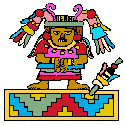 |
Related Topics:History of the RegionAcoustics of Archaeological Sites Dances from the Oaxacan Coast |
No major archaeological sites are known to exist in the region, with the exception of a ceremonial center at Piedra Parada Jamiltepec west of Puerto Escondido. There are at least 128 registered archaeological sites along the coast of Oaxaca. Most date from the post-classic period, 1250-1522 AD and most are thought to have been under the control of Tututepec rulers. Some sites have remains of homes or stone walls and many pottery fragments and figurines are found. Pottery found near Puerto Angel is in the Museo Frizzell de Arte Zapoteca in Mitla as well as private collections in Puerto Angel.
A Mixtec ceremonial center was recently discovered just east of Puerto Escondido and is considered a major discovery. The site has at least 4 pyramids and a ball court. A number of large carved stones have been found. It is located within the municipality of Santa María Colotepec near the village of Charco Seco, about 10 kilometers off the coastal highway. Situated on a hilltop, it commands a spectacular view of the Pacific coast. The site is not open to the public.
Excavation of a site at Zipolite was begun in 1962 under the direction of Donald Leslie Brockington and assistant William Hurley of the University of Wisconsin. Several pits were dug either down to bedrock or to the point that water intrusion halted progress. Some 65,000 pottery fragments were retrieved and two burials were noted. Results of this study were recorded in painstaking detail in a thesis entitled "The Archaeological Sequence from Sipolite, Oaxaca, Mexico" by D. L. Brockington, 1966. (Sipolite is an alternate spelling of Zipolite, Cipolite is another.)
Brockington concluded that the site had been continuously inhabited since Preclassic (before Christ) times with no evidence of radical changes in pottery styles. There was evidence that fine pottery of other areas was either copied or imported but "utility" wares changed little over time. A small isolated population is suggested with population growth limited by arid conditions and low agricultural potential.
There is reportedly a Chatino archaeological site with large carved stones near Nopala, north of Puerto Escondido.
 |
Related Topics:History of the RegionAcoustics of Archaeological Sites Dances from the Oaxacan Coast |